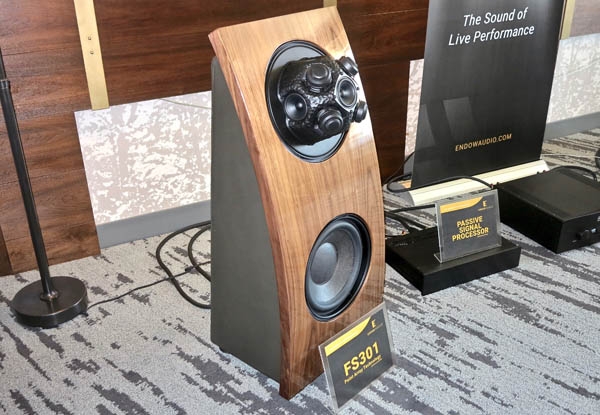| Columns Retired Columns & Blogs |
Take a look at the 'Tunnel boring machine (TBM)' also known as a 'mole' in Wikipedia ..........
The top portion of the Endow Audio speaker drivers look somewhat similar :-) ........

Once my eyebrows had lowered enough to get out of the way of my ears, I discovered that Endow Audio’s prototype FS301 loudspeaker ($44,000/pair), whose price includes a patent pending outboard passive signal processor, delivered lovely sound on David Wilcox’s “Chet Baker’s Unsung Swan Song.” Paired with an integrated amp from Hegel whose model and price I failed to record because I was too busy listening, the FS301 conveyed an excellent sense of venue and space on a Holly Cole track.
The speaker, manufactured in Kentucky, claims a frequency response of 40Hz-20kHz, with a gradual bass roll-off attributable to its sealed box. Learning that, I was possessed to throw the kitchen sink at it. Doubtful of what I’d hear, I turned to a stream of the fff total assault of part of the second movement of Shostakovich’s Symphony No. 11, in the recent recording from Andris Nelsons and the BSO that won a Grammy Award for engineering. That’s when I discovered how superbly this speaker handles complex information in the lower frequencies. And that’s without room treatment. While its bass wasn’t as deep and full as on the towering six-figure system from Göbel and CH Precision, its absolute control from top to bottom left me in awe. That, combined with an astoundingly huge soundstage, convinced me that this speaker is a major achievement.
Production of the Endow Audio FS301 is expected by year’s end. It will be sold online, direct. The FS301 is the company’s first speaker that uses their point-array technology. Designed by David Strunk, who designed his first sound board when he was 12, learned about live sound from exposure to worship music, and is now 29 years old, the FS301 claims to be a mathematically accurate point source. The speaker’s outboard "passive signal processor" splits the signal five ways before sending it over custom cabling to (1) the subwoofer, (2) the point array’s center driver, (3) the point array’s four drivers that more or less point toward the four rear corners of the room, (4) the array’s four other drivers that point left, right, up, and down, and (5) the hidden woofer behind the point array. The speaker has a nominal impedance of 8 ohms, can handle a nominal power rating of 300W, has a peak output of 100dB at 1 meter, weighs 90 lb, and measures 40” tall. Look for it at the Capital AudioFest, Florida Audio Expo, and AXPONA. It may blow your mind as it blew mine.

Take a look at the 'Tunnel boring machine (TBM)' also known as a 'mole' in Wikipedia ..........
The top portion of the Endow Audio speaker drivers look somewhat similar :-) ........

It also looks like the top portion of R2-D2 or the color lights of the rotating globes in the discos :-) .........

I was holding back ...... Now, I'm gonna say it ........ Think about Greek God 'Priapus' ........ See Wikipedia ..... See those pictures in Wikipedia :-) ..........

George Short took acoustic suspension to a higher level of linearity in 1988 with his MAPD alignment.
The short version (pun intended) was posted on George's website associated his loudspeaker and component business, North Creek Music Systems.
George moved from NY to NV, and now works for Wisdom Audio. The business and website are now defunct, but the webpage on MAPD is still available on the Internet archive (link below).
https://web.archive.org/web/20080207011833/http://www.northcreekmusic.com/MAPD1.htm
The more expansively detailed explanation lives exists in his 1988 thesis (link below).
https://vtechworks.lib.vt.edu/bitstream/handle/10919/45955/LD5655.V855_1988.S432.pdf?sequence=1&isAllowed=y

That said, for 2 or 3 octaves above 8_Hz, I would argue in favor of separate low frequency subsystem using subwoofers loaded with passive radiators. Above that I would argue in favor of gradient alignments (eg. open baffle dipole).
Modern woofers are available that have much better motors and suspensions as compared to long ago when acoustic suspension was in vogue.
Opinions vary.

C'est seulement de l'argent :-) ........

The equipment in the room consisted of:
Streamed from MacBook Air
Hegel H360 integrated amplifier
Endow Audio PSP
Endow Audio FS301

One more integrated amp for JVS to review ......... Hegel Reference H590 :-) .........

All I can say is I found the sound from these speakers to be very bright and harsh.
I visited about 2 PM on Friday, so it's possible they tuned things later in the weekend.

All I know is that I wouldn't wanna piss it off.

those piccolos, blaring brass, and all the rest that gets going in the Shostakovich will be piercing. On this system, it wasn't. Yes, perhaps everything hadn't yet gelled on Friday, or they streamed a lousy recording, or both



I think I need new hobby. 44k for this disaster of design. I feel sorry for you Jason. It must be hard to keep a straight face when presented with this type of product. Definitely not Kentucky's finest...
